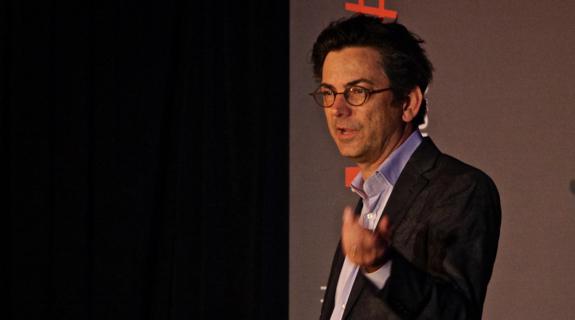If you’ve been to a PromaxBDA’s The Conference any time in the past 25 years or so, chances are you’ve gotten a chance to hear media marketing expert Lee Hunt.
One of the most popular conference sessions over the past decade is Hunt’s “New Best Practices,” which he usually presents in front of a standing-room-only crowd. In that session, he offers intelligence and insight into what’s happening right now in the world of television, whether that’s on broadcast, cable or SVOD.
This year, Hunt is scoring a hat trick and presenting at all three of PromaxBDA’s major events: PromaxBDA Europe in Berlin March 23-24, The Conference in Los Angeles from June 9-11, and Station Summit in Las Vegas June 23-26. He’s well suited to address these three disparate audiences since he trains TV executives across the globe after getting his start on a local public TV stations in his hometown of Dallas.
Like many people who find themselves working in on-air promotion, he didn’t really know what it was or understand it until he found himself doing it. But he was a quick study.
After leaving Dallas, he moved to New York City, where he worked for Satellite News Channel out of Stamford, Conn. The channel was ABC and Group W’s attempt to take on CNN, but it folded within 18 months, and instead was purchased by Ted Turner and turned into Headline News.
After that, Hunt moved into New York City, where he got in on the ground floor of launching, branding and marketing such upstart cable networks as Lifetime, VH1 and TNT, networks he still works with today.
Lifetime, which initially positioned itself as talk television and then switched its focus to TV for women, “was the first brand reposition I ever did.” Little did he know there would be many more to come.
After that, Hunt moved on to VH1, doing a brand reposition for that network, and then down to Atlanta to work for TNT.
From there, “I came back to New York to do program development for MTV and quickly realized that was not my thing.”
Instead of going back to work for one network or another, he took a right turn and launched his own creative services company, Lee Hunt Associates, continuing the work he had started for Lifetime, VH1 and Turner but instead working for himself.
In 1999, he sold that company to digital services company Razorfish. He had intended to move to London to work for the new firm, but instead found himself a victim of the bursting tech bubble. It was time to pivot again.
In 2001, Hunt founded another company: Lee Hunt LLC, and that’s the company he runs today with feet in lots of different pools.
“I spent the 80s on the client side, the 90s on the vendor side and the oughts on the consultant side,” he says.
Lee Hunt LLC, operating out of his home base in Mt. Tremper, New York, has four primary objectives: brand strategy, which Hunt says is still his favorite; on-air architecture, which is helping networks design an on-air experience that keeps viewers engaged through all of the programming, commercials and promos; domestic and international training; and his latest endeavor, Denver-based CMO Intelligence, which breaks down for networks exactly how much time and effort they are spending on marketing.
Hunt has worked on network brand strategy for such powerhouses as Disney Channel, USA Networks, FX Networks, Hallmark Channel and E! While Hunt himself says he “doesn’t do taglines,” he did give FX the idea for Fearless and designed strategies for USA’s Characters Welcome (Hunt gives USA Networks President Chris McCumber credit for that tagline) and for E!’s Pop of Culture.
He also analyzes networks’ on-air architecture, figuring out the best ways to keep viewers glued to their screens.
What ultimately ends up on networks is “all put together in silos,” Hunt says. “Programming does their thing, promotion does theirs, sales does theirs. No one had paid a lot of attention to how it’s all put together. Things really changed in 2007 when we switched to C3 ratings [commercial ratings over three days of viewing] because the networks started getting paid by how many people watched their breaks.”
“One of the things we do is reduce time-shifted fast-forwarding,” Hunt says. “TiVo provides second-by-second ratings so we can look at a lot of viewer behavior. There are very few ways you can get people to not fast forward through a break, but there are some tactics that work.”
Lately, what’s taking a huge chunk of Hunt’s time — when he’s not preparing for trips to Jersualem, Berlin, Brazil and Russia — is CMO Intelligence, which will provide “syndicated competitive analysis” to clients.
Looking ahead, Hunt says he’s been seeing a lot of cross-channel promotion, when NBC, for example, promotes The Blacklist on TNT, or E! promotes The Royals on Bravo.
“I recently looked at a major cable network in primetime and there was more competitive cross-channel promotion than there was on-air promotion for that channel,” he says.
“Advertising revenue is down and when that happens, the first thing that gets pulled is on-air promotion even though that’s the most effective and efficient tool that we have. When you are pulling your own on-air promotion off the air and selling that time to one of your competitors, that’s not a good long-term strategy for the success of your network.”
What Hunt will tell PromaxBDA audiences this year remains to be seen, but no matter how and when audiences watch TV, it all boils down to one simple thing, Hunt says.
“When people watch television, they don’t think, they experience. They have to understand and relate to what they are watching immediately. If they have to stop and think about it, it doesn’t work.”
Hear Hunt speak at PromaxBDA Europe in Berlin, being held March 23-24. For information and to register, go here.
Tags:













































__twocolumncontent.jpg)











